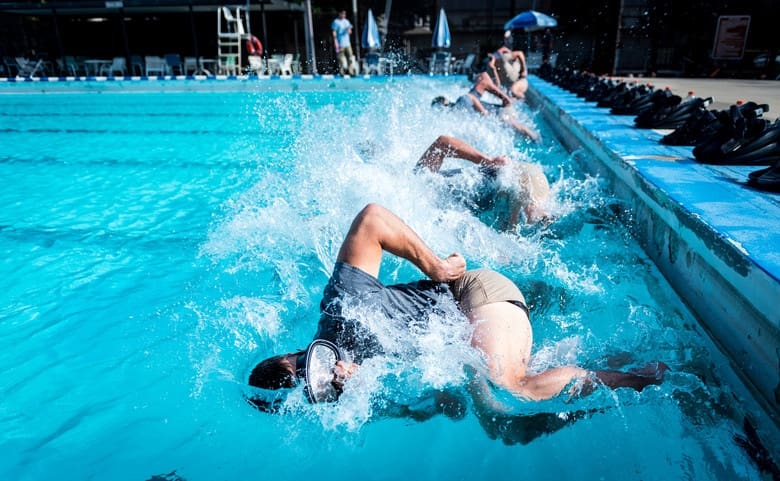JOINT BASE SAN ANTONIO-CHAPMAN TRAINING ANNEX, Texas (AFNS) —
Air Force Special Warfare has refined its rich history of Assessment and Selection for entry into the special tactics and Guardian Angel career fields.

A&S is a character-based process that is indexed off of physical performance and mental fortitude, but fuses the cognitive domain to build a unit of action–an agile and adaptive operator. A&S is a high performance system designed to prepare operators for uncertainty, to embrace pressure and improve their crisis management abilities.
“No inflection point, we’ve been doing this for 65 years so this isn’t new to us,” said Chief Master Sgt. Jamie Clark, Special Warfare Training Wing command chief. “Our A&S has always been about developing the operator, a problem solver, not a specialty. Let’s not mince words though, it starts and ends with grit. At the very core, our A&S is a talent management process designed to build an Air Force joint leader to project airpower in combat, humanitarian and gray zone operations.”
In January of 2019, the wing revised its previous A&S into a single, more comprehensive process designed to push and test the upper limits of a candidate’s physical, mental and cognitive abilities. The course is four weeks long and aspiring attendees consist of pararescue, combat control, special reconnaissance, combat rescue officer and special tactics officer candidates. Previously, candidates of these career fields attended different initial entry courses such as the Pararescue Indoctrination Course or Combat Control Selection Course.
“In the past, combat control and pararescue candidates went through the Indoctrination Course together,” said Senior Master Sgt. Lopaka Mounts, A&S superintendent. “Bringing combat control, pararescue and now special reconnaissance back into the same A&S ensures candidates are evaluated along the same guidelines for trainability, suitability and durability.”
This A&S is no different than other special operations career fields across the Department of Defense. Its task and purpose is to ensure candidates have the requisite attributes to operate in any environment under extreme conditions, either individually or in small teams with limited to no support infrastructure. Stress is levied on candidates to simulate and inoculate them to high-risk, reduced signature and politically sensitive situations they will face in their careers, so attrition is expected.
“There is always going to be stress put on candidates in this course because we need to ensure they are able to perform. Therefore, attrition is unavoidable,” Mounts said. “The physical and mental tests throughout A&S is purposeful, anchored to and meant to ensure our candidates meet mission requirements. Candidates should come to the course ready to crush the standards that are in place.”
The goal has always been readiness and lethality while increasing operational placement and access, as well as range and maneuverability to operate in contested and noncontested environments. In essence, it’s about preparing the environment, which is what the Air Force envisioned when it created GA and ST. A&S is the mechanism to achieve this goal.
“We’re extremely proud of our GA and ST lineage and history. A&S is vital to what we represent, why wouldn’t it be? It’s the benchmark experience of who we are and fight for,” Clark said. “Our goal has and continues to be to position the Air Force to be successful, to create an unfair fight so we win. This is no more evident than the ultimate sacrifice paid by some of our heroes like William Pitsenbarger, John Chapman, Jason Cunningham, Scott Duffman, Scott Sather, Andy and Sean Harvell and Bill Schroeder.”
By 1st Lt Jeremy Huggins, Special Warfare Training Wing


Make Indoc Great Again…..
I would be curious as to how the middle aged people feel about this-as in the people who are mid career in this field.
Selections have always been a point argued from several directions. Certain people have melt values that you just cant seem to locate in a selection or initial assessment. Those being high or low values.
I bring this up because FORECON had a fairly good assessment (relative to the time and service itself) when it stood up again some 30 years ago (approximately). Shortly after it had done so for the dual deep green/black (just the term for the color of the uniforms) mission they had green and black platoons.
Following some time and realizing the huge cost of dual platoons supporting the ARG/MEU they combined the platoons. This was just a differential that caused some grief. The organizational members tended to have different personalities. Veterans of deep reconnaissance missions were geared one way. Chess thinkers, pacing minds that tended to be lean, greyhound types that could go 2 days on a cup of water and a chocolate nut cake. The other side tended to be more near term/mid term fast paced dynamics and carried more physical mass (and appropriately) for the missions. Mixing these guys sometimes made for interesting playouts, opinions, etc.
Point to ask here is would not a tailored selection or a diverge point make more sense? Seems it goes back and forth every decade or so to combine, separate, repeat.